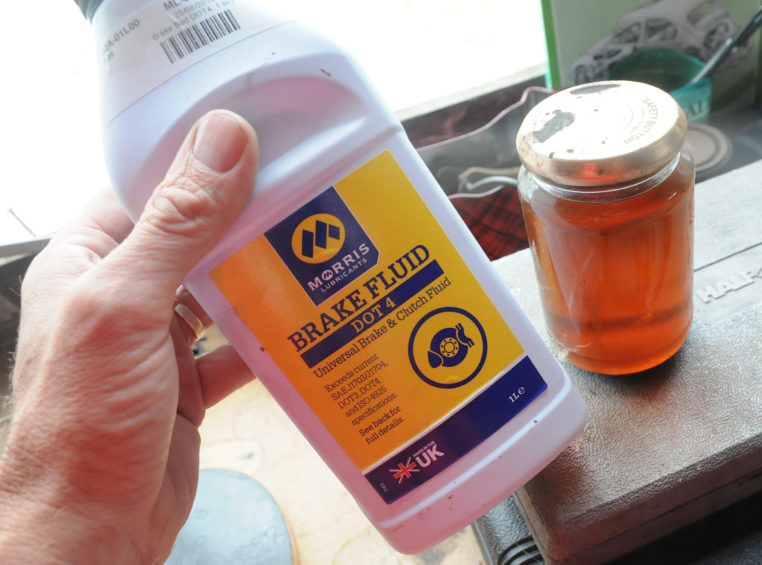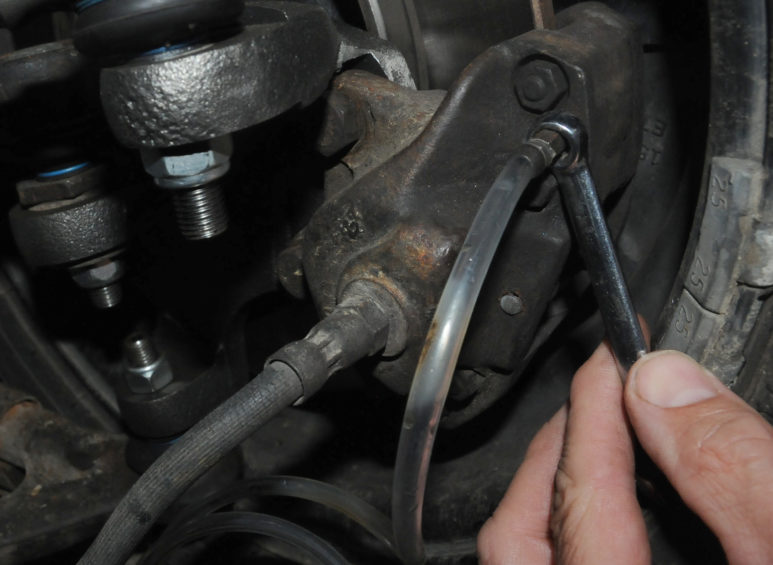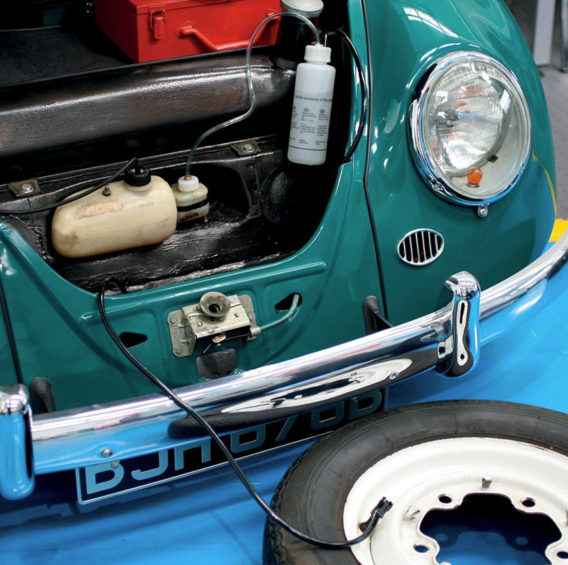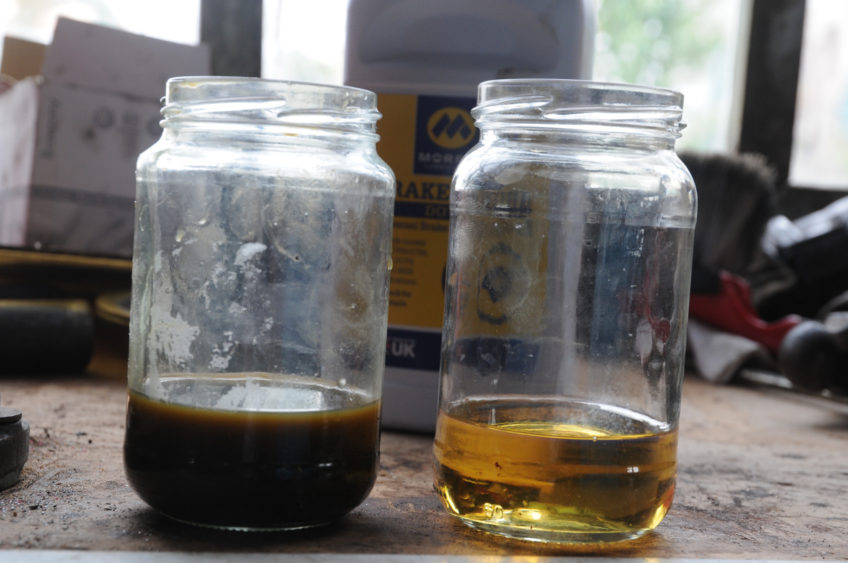VW brake fluid is clever stuff. It’s virtually incompressible, has a high boiling point and yet costs buttons to buy. So why then do we find it so easy to ignore?
VW Brake fluid has a fair bit of responsibility heaped upon it, doesn’t it? When we step on the anchors, we rely on it to do the necessary, work under pressure and bring things safely to a halt. Yet, like virtually ever other car component, it has a definite lifespan and shouldn’t be overlooked as an essential element of a routine maintenance schedule.

Water shame…
The problem is, despite its complexity, brake fluid is hygroscopic – in other words, it absorbs moisture that permeates through the rubber hoses, seals and via various fittings. And as soon as moisture’s been absorbed, the fluid becomes less efficient at its job. Not only that but the moisture can corrode the brake system’s internals, causing pistons to seize and metal brake pipes to rust from the inside. Which is why brake fluid should be replaced every two years.
Which VW brake fluid?
All brake fluids must comply with North American DOT specification and most cars use either DOT 3 or DOT 4 glycol ether-based types. The latter has a slightly higher boiling point and is said to absorb less water, so it is often seen as an upgrade for cars that were originally designed to use DOT 3. Both are compatible, so you can mix them together if you should so wish.
3, 4, 5, 5.1…
DOT 5.1 has an even higher boiling point, but is considerably more expensive to buy and really only for competition cars. DOT 5 is different again, being a silicon-based fluid – so you can’t mix it with other brake fluids. It won’t strip paint, but it is slightly compressible, which might compromise the braking efficiency of cars with ABS and traction control systems.
Incidentally, don’t pay more for fluids that shout about being ‘synthetic’ – they’re all synthetic.
Assessing condition
Fresh brake fluid is a light straw colour (as on the right, above) – but as it becomes contaminated with water or failing internal seals, it becomes much darker. As moisture is absorbed, the fluid’s boiling point becomes lower. There are specialist devices to assess a brake fluid’s boiling point – but they’re expensive and only bigger garages are likely to have them. Either way, adhering to the two year regime and flushing the whole system through with fresh, new fluid is always the best, most fail-safe method of ensuring it’s still able to do its job properly.
Some brake fluid reservoirs have a filter that traps debris, so make sure it’s clean before changing your fluid. And don’t forget, brake fluid will strip paint in seconds so be careful of any drips.
Let it bleed
To change your VW brake fluid, it’s simply a case of flushing the new fluid through, which is done by following the brake bleeding process. There’s several ways to bleed brakes. The conventional method is to ease a clear piece of flexible pipe over the bleed nipple on the brake cylinder, open it, and get someone inside the car to pump the brake pedal. You should generally start at the caliper furthest from the master cylinder and regularly check the level in the reservoir – topping up if necessary. Never let the reservoir become completely empty, and pour new fluid in slowly to avoid introducing any bubbles. The other end of the pipe needs to be immersed in a jar of clean brake fluid. Bubbles in the pipe indicate the presence of air, all of which must be bled through before your helper holds the pedal to the floor and the nipple is retightened. You continue to do this at all three corners until fresh, clear fluid starts to come through. Once you’ve done this, the brake pedal should feel nice and firm and not at all spongy.

All by myself…
You can also buy a ‘one-man’ kit that features a one-way valve in the pipe which makes life easier if you can’t find an assistant; we offer a version by Gunson’s called the Eezibleed brake bleeding kit here. Another method which enables you to bleed the brakes on your own is to use a pressurised bleed kit, powered by compressed air from a car tyre (as below). These supposedly reduce the risk of damaging the master cylinder seal, which can happen when the brake pedal is fully depressed.

Another option, instead of pressure bleeding brakes, is to vacuum bleed them instead. The principle is just the same, but instead of pushing fluid through the system, you drawer it out using a hand-held pump.
Like all things, though, you might find the old methods often work out simpler and cheaper!
Ian
If you want some tips on how to improve your brakes, read our post here.
The opinions expressed here are the personal opinions of the author and do not necessarily represent the views and opinions of VW Heritage.



Quite a good and timely tip. One thing to beware of is/are corroded bleed screws. I have hit this problem several times in the 50 odd years that I have been playing with Beetle brakes. The little rubber cap that fits over the bleed screw does the job of keeping dirt out of the screw but does nothing to protect the hexagon part of the screw which is prone to rust away. My solution to this problem is to discard the rubber cap, take some plastic piping of a suitable size, cut a piece that is long enough to cover the whole of the visible screw and heat seal one end.
Now having fitted a nice new bleed screw and completed the bleeding, fill the piece of sealed tubing with silicone grease and force the tube onto the bleed screw. The whole thing is now sealed up, waterproofed and will be intact when you come to do the next fluid change in two years time.
Why waste your time with glycol based brake fluids? You might as well use Coca-Cola! It’s all a ploy by the industry to keep the customers buying brake components I’ve used silicone brake fluid in every car I’ve owned since around 1984, when it 1st became available. It’s used by the American military, and made in the US by Dow-Corning, and that is where it became 1st available.
Last year I sold a 1959 Beetle, which when replacing the whole braking system in 1984, I used silicone brake fluid for the 1st time. When I sold it last year, it had the same brake fluid in it, although sitting around in lock ups for 30+ years, and the car passed its MOT. Try doing that with glycol brake fluid, and after a few years, you’ll press the brake pedal down, and it’ll stay there, with everything just about seized up.
There is so much guff talked about silicone brake fluid, designed to scare people off using it, and generally this works. All fluids are compressible, but to varying degrees. Yes, silicone fluid is slightly more compressible, and the effect varies from one brake system to another. I’ve used it in modern ABS systems, without any problems whatsoever.
If you have a classic car that spends most of its life sitting around, then silicone brake fluid is a must. How many cars have their normal brake fluid changed every 2 years? Very few, and normally only when new, to keep the warranty intact. All designed to keep garages in business!
Thanks for your comments Martin, a very useful first hand insight.
Our back brakes bleed properly but there is no fluid coming out of our front breaks. We checked the resivior and it is full, what do you think is the issue?
John, I am sure by now you have solved the issue, but just in case, I would recommend removing the bleed screw completely, then remove the build-up that’s likely occurred on the threads. Also, using a scraper pin tool, I would check to make sure the plug hole is free and clear of whatever is clogged. Of course, whenever fully removing the bleed screw make sure you have something under the caliper as fluid will slowly begin pouring out. This should fix the problem temporarily, but it would be wise to invest in new screws as they are prone to rusting! Hope this helps!
Great comments. Thanks. I have a 1960 beetle which seems to be leaking brake fluid from the reservoir. Just had the brake cylinder replaced but there is a more-or-less odorless patch on the drip tray underneath the font wheels. It is coming from the center of the car and seems to be dipping from the body rather than off to the side where the cylinder is. Any thoughts please?
You made a comment “never let the reservoir get completely empty.” Why is this, and what steps should I take if it is empty? After having slow braking, I checked the fluid level and found none (I’ve yet to unscrew the cap to see if there is any in the system at all) What is the first step here? Should I start by adding fluid and bleeding the brakes? (I have a 1974 type 2)
If the reservoir becomes empty then it will draw air into the system, and you’ll have to start all over again.
So keep it topped up with fluid at all times.
Is it possible to switch from dot 4 to dot 5 and how would you do this in terms of a method as presumably in this instance you can’t keep the Reservoir level topped up as the two fluids aren’t compatible?
Please can you help, i have a 1972 beetle for 18 years and all has been fine until the this year. My car started to pull to the left, i have changed the calliper but did not help the front left hand brake has started to lock up and get hot, then the brake pedal goes hard . Have changed the front brake hoses but still not cured the problem. the other day i drove the car for about 10 miles [on a very quite road] by just stopping with the hand brake but again the last few miles car tarted to struggle for power, when i got home the left hand brake was very hot and brake pedal had become very hard . How can this be when i have not used the brake pedal, please help as i am now very confused. thank you .